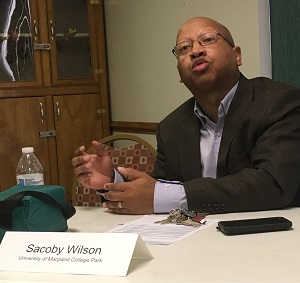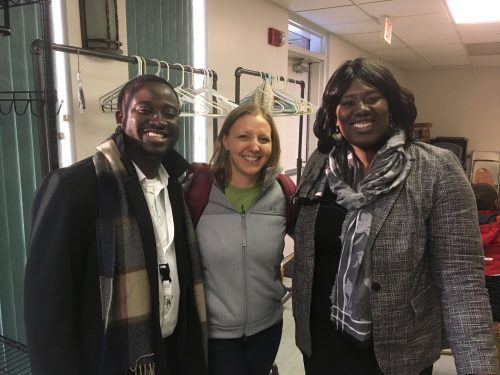On Saturday, February 3, 2018, the TEX-Brandywine project held its first community education and engagement forum at the Union Bethel African Methodist Episcopal Church in Brandywine, Maryland. The 4-hour event served as an opportunity for concerned citizens in Brandywine and surrounding neighborhoods to engage with and hear from peers, potential political representatives, and recognized subject experts. It was a multi-generational event attended by residents including grandparents and young children, as well as four candidates for public offices including District 9 County Council and State Delegate. For the TEX project team, it was an opportunity to expand awareness of air quality and the environment as it relates to public health issues with the broader community, and to receive feedback and insights on the concerns and quality of life of participants.

The event began with a brief introduction to the community’s TEX community science collaboration, and the distribution of a survey crafted by the project team, Kamita Gray (Brandywine TB Southern Region Neighborhood Coalition) and Akua Asa-Awuku and Emmanuel Fofie (University of Maryland – College Park). The survey was approved by the University of Maryland’s Institutional Review Board to assure protection of the rights and welfare of participants. The survey was designed to serve two functions:
- To discover baseline information about residents (e.g. demographic data and health), and their relationship to their air (e.g. how often they have had to reduce outdoor activity because they thought or felt the air quality was bad.) and
- To provide an opportunity for community members to contribute to the development and structure of follow-up air sampling activities in the community.
Following completion of the surveys, the event featured speakers and discussion regarding air quality, public health, and environmental justice – and how they intersect in Brandywine:
 Environmental Justice, Cumulative Impacts, and Air Quality Concerns in Brandywine Maryland
Environmental Justice, Cumulative Impacts, and Air Quality Concerns in Brandywine Maryland
Dr. Sacoby Wilson, Associate Professor, Applied Environmental Health, School of Public Health, University of Maryland – College Park (Guest presenter)
Sacoby described environmental justice as a science and social movement, and a direct descendant of the Civil Rights Movement. People of color and those who are low income face disproportionate exposure and a higher risk of exposure to harmful environmental contaminants. This exposure (for example, to air contaminants like particulate matter, PCBs, and lead) results in negative health outcomes including asthma, cancer cardiovascular disease, diabetes, and poor birth outcomes. This exposure exists in Brandywine in the form of surface mining operations, nearby power plants, heavy diesel traffic, and other industrial activity.
Introduction to Air Quality: What are the pollutants, how are they measured, what are air standards
Dr. Akua Asa-Awuku, Associate Professor, Chemical and Biomolecular Engineering, University of Maryland – College Park
Akua shared the science of airborne contaminants and how they can be addressed. Indoor and outdoor air pollution kill more people annually than food and water-related causes. Reduced lifespans and health problems affect the economy greatly. Concern should extend beyond direct sources to “downstream” contamination, as many contaminants from sources like power plants are reactive and can change once out in the environment. The Clean Air Act established 6 Criteria pollutants (particulate matter, CO, NO2, SO2, lead and ozone). These pollutions define regional air quality and are monitored approximately 30 miles north and 40 miles east of Brandywine. Due to the direction of prevailing winds and diffusion, however, it is unlikely that these monitors reflect the air the community breathes.
Akua closed her presentation by sharing 7 steps to address air pollution problems, expressing that citizenship awareness and buy-in is an essential foundation for this process:
- Scientists and Citizens recognize that a problem exists
- Citizens demand the problem be solved
- Government leaders develop laws to address the problem
- Government, citizens, business, industry, lawyers, and other stakeholders develop the regulations that detail how to use the law to reduce pollution
- Engineers develop new technologies to reduce emissions
- Government and Citizens monitor progress and enforce the laws
- Laws and regulations are revised to maintain progress and use new knowledge of the problem

(L-R) Emmanuel Fofie (UMD College Park), Crystal Hall (Sierra Club of Maryland), Akua Asa-Awuku (UMD College Park)
Community Health and Air Pollution
Crystal Hall, Baltimore Beyond Coal Organizer, Sierra Club of Maryland (Guest presenter)
Crystal shared the Sierra Club’s commitment to reducing the risk posted to families from coal and other energy-related pollution sources, and advancing action in the state toward a 100% green and renewable energy supply. This action is underscored by recognized needs to recognize and protect vulnerable populations through policies aimed at equity rather than equality.
During the day’s discussion, one attendee expressed fear about the air in Brandywine. The response was that this is not small or easy issue to address, but the first step is to combat fear with information.
This event was the first of several for the Brandywine-TEX project team. There is interest in the community in having additional, follow-up gatherings to continue to build community awareness surrounding this issue. Leaving the event, participants were challenged to talk to their friends, neighbors and families about the severity of this issue.
Next steps for the TEX Brandywine project team include analysis and continued distribution of surveys to enhance the team’s understanding of community health and perceptions in the community. Simultaneously, the project team is pursuing additional grant funding to finance seasonal air sampling in the community.

Flyer advertising the event created by Kamita Gray, President, BTB Coalition

